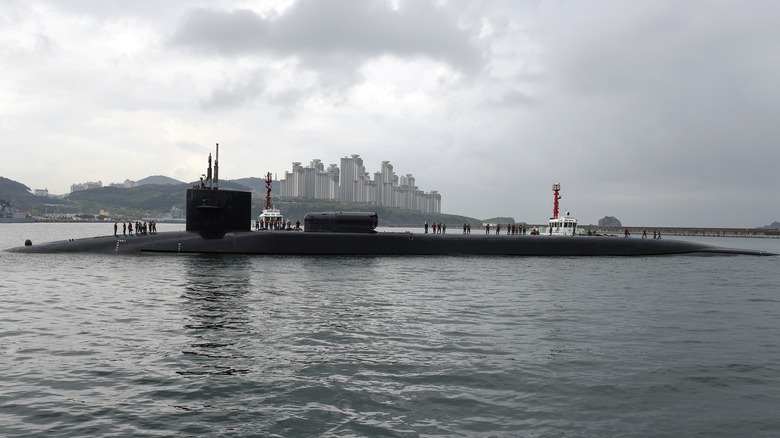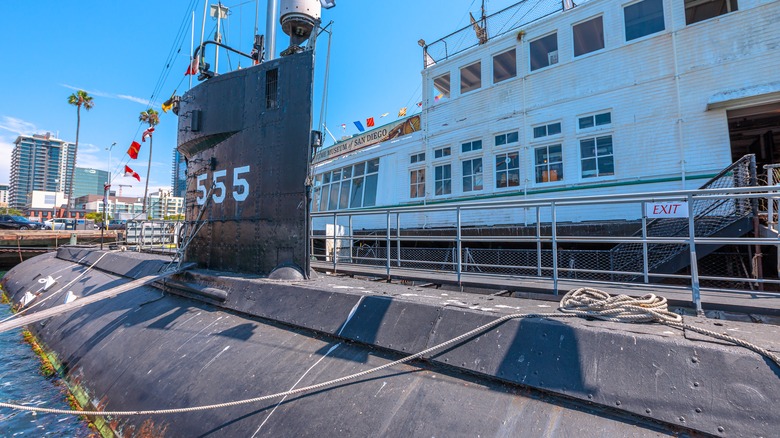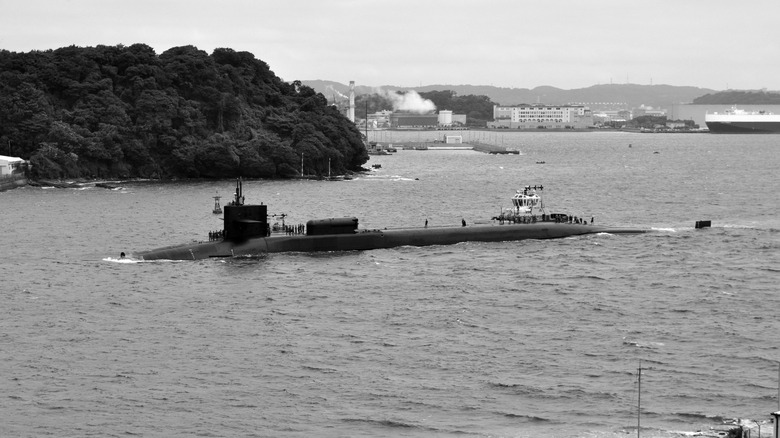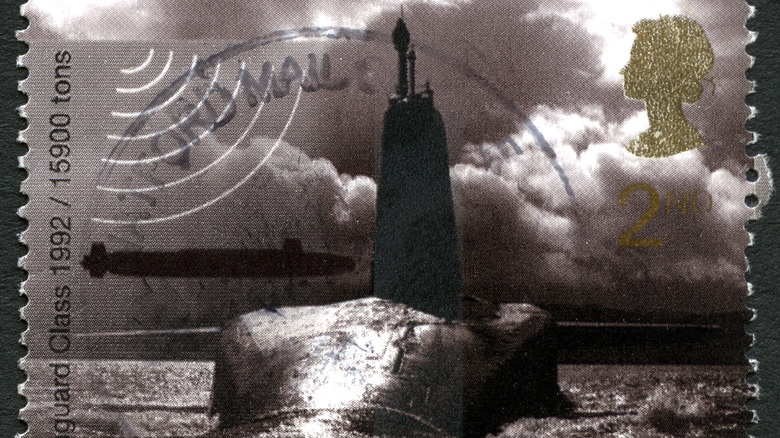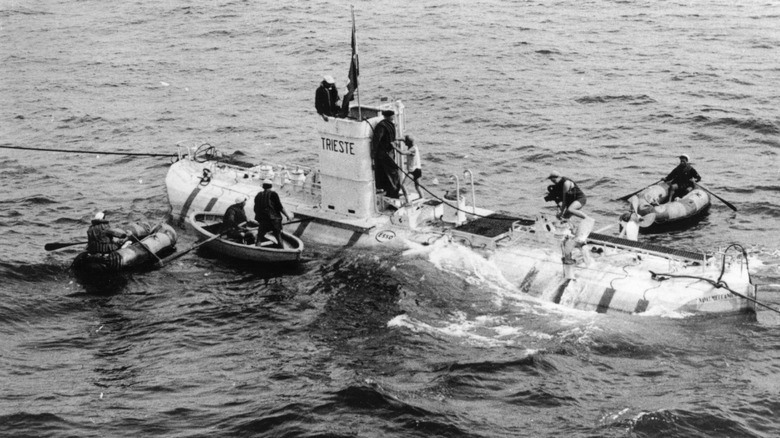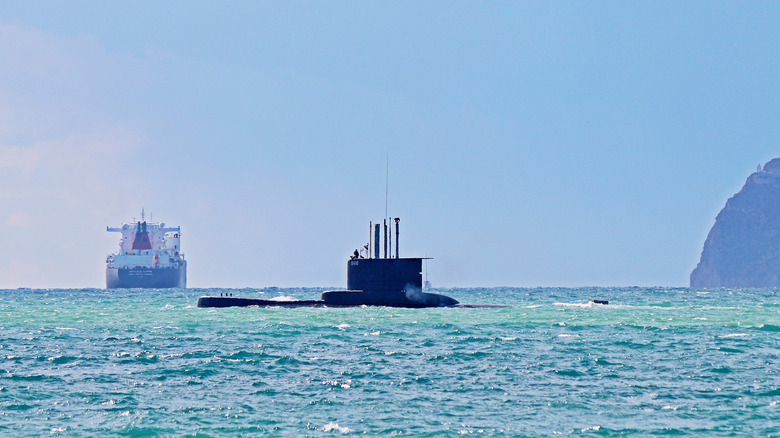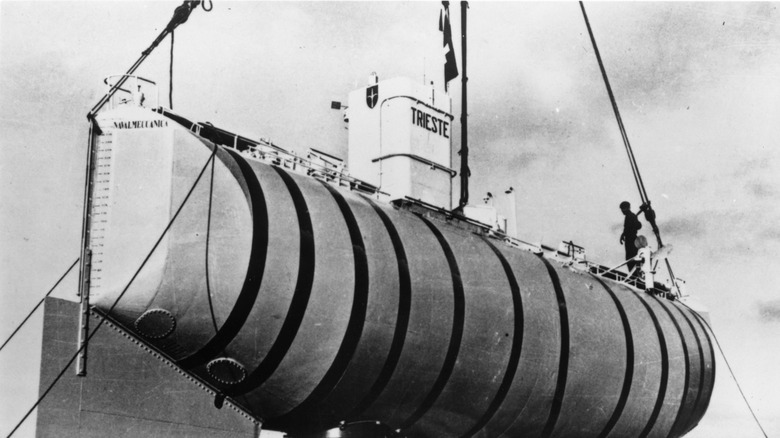How Deep Can A Military Submarine Go?
The world was gripped by horror in 2023 as the OceanGate submarine met its tragic fate. The submersible, per CBC, was designed to reach dizzying depths of up to — or rather down to — 4,000 meters. Its target destination, the wreckage of the lost ocean liner Titanic, lies approximately 3,800 meters deep in the Atlantic. Though a specialized vessel in itself, it may make you wonder just how deep military submarines can penetrate in comparison.
The U.S. Navy reports that it boasts four submarines equipped with guided missiles, 14 with ballistic missiles, and 53 attack subs. These vessels, of course, are not all uniform, being built with different specifications capabilities and equipped with arsenals to suit their unique missions. Due to the classified nature of military intelligence, however, there isn't a definitive answer to the fascinating question of how deep a military submarine can go.
What we can see, however, is the available information relating to a selection of such vessels from around the world, and what's known of the technology that allows them to reach those depths. We'll also explore the capabilities of submersibles, similar yet distinctly different machines to submarines.
The limits of submarine travel
The deepest a submersible of any kind has ever descended, the BBC reported in May 2019, was 10,927 meters or approximately seven miles down. This was achieved by Victor Vescovo aboard Triton Submarines' submersible DSV Limiting Factor.
Can military subs reach such depths? Armed forces around the world, after all, have access to the fastest, stealthiest aircraft, and other such technology that is generally strictly off-limits to civilians. When it comes to true military submarines, then, USS Dolphin came out on top. The vessel, which is 50 meters in length, was completed in 1968 and wasted no time in demonstrating exactly what it could do. That November, its pair of GM V71 engines pushing out 425 hp (it also boasts dual generators measuring at 250 KW) carried it to world-record depths, and it's reported to have reached 910 meters below.
With the data being a guarded secret, it may not be surprising that USS Dolphin has been challenged for the title of deepest diving true submarine. The Soviet Union's Komsomolets, which arrived a little after the Dolphin in 1974, was built for the rigors of depth with a titanium body. Unlike its American counterpart, it was equipped with nuclear power. It was said to have reached depths of just over 1,000 meters in 1984, though the model sank in 1989 after a fire on board. It was wrecked in the Barents Sea.
The depths the U.S. Navy's current crop of submarines can reach
For an attack submarine, the priority is not simply firepower, but versatility, maneuverability, and unpredictability too. For these reasons, then, the boon of being able to hide in the depths cannot be overstated. This holds true for the U.S. Navy's sizable fleet of submarines.
As noted, of course, the precise limits of the depths models such as the Viriginia class can reach isn't the sort of data the military would seek to advertise far and wide. It is known, however, that these attack subs are capable of reaching some considerable depths indeed: They can travel at more than 250 meters below the surface, though the precise limits of their capabilities aren't common knowledge. They're equipped with a nuclear reactor, which can allow them to remain in the depths for longer stretches, not to mention MK48 torpedoes and Tomahawk missiles with which to engage potential targets below and above the waves.
The U.S. Navy's Ohio class submarines, which were introduced in the early 1980s, were designed as guided and ballistic missile vessels. They're among the largest in the country's arsenal, at 170 meters long, with a hefty displacement of 18,750 tons. USS Ohio, the first of its class, has a Navy-reported test depth of 240 meters. This is a similar level to the depth of the Viriginia Class models, though, again, the test depth isn't necessarily indicative of the very limits of the model's capabilities.
The depths other military submarines can achieve
Outside of the U.S. military, other nations' navies boast submarine fleets of both similar and different capabilities. The British Royal Navy, for instance, wields Vanguard class subs, which are ballistic missile subs comparable to the Ohio class. They are considerably smaller, at just below 150 meters long, and armed with Trident 2 missiles, and their power source is also a PWR series reactor. The Vanguard class can dive to depths of up to approximately 500 meters, a depth that a Vanguard almost accidentally exceeded, with potentially disastrous results, when a depth gauge failed in November 2023.
The British Trafalgar class, meanwhile, is faster and smaller, with a top speed of 30 knots and at 85.4 meters long. Its design incorporates anechoic tiles, which form a sort of rubber shell on the submarine that help to reduce an adversary's ability to detect the vessel. This is a huge advantage for any such machine, but especially for one that has been modified for recon purposes as the Cold War era Trafalgar class was as it aged. As befits this, the sub is capable of descending to great depths, with an operation limit of approximately 400 meters (functioning up to 600 meters). Impressive as these feats are, there's an important distinction to make: A submarine operated by the navy, though intended for research rather than for active combat, is still a military submarine. Which brings us to another unique vessel.
The U.S. Navy's Trieste and its astonishing voyage
Trieste wasn't chosen for reconnaissance, attack, or any other aspect of warfare. Instead, it's perhaps one of the most fascinating and unique scientific instruments the world has ever seen. Created by Auguste and Jacques Piccard, an enterprising scientific father-son duo from Switzerland, Trieste first reached U.S. Navy hands in 1958. Two years later, the submersible made its famous descent to the very bottom of the Mariana Trench's Challenger deep, 10,916 meters down.
The Navy's Don Walsh, who joined the elder Piccard on the first-for-humanity voyage, would later tell Rolex that a cracking Plexiglas window on the outside of the vessel caused "one moment of pure terror" on the nine-hour journey into the depths. The vessel, fortunately, was built to withstand such punishment, and the monstrous pressure down there (which was around 1,000 times stronger than above the waves). The vessel used an ingenious system whereby lots of small pieces of metal were released to reduce its weight, and so allow it to return back to the surface.
The Navy purchased Trieste for $250,000 at the time, and it now resides in the National Museum of the U.S. Navy. The enterprising machine proved, essentially, that it's possible for military submarines or submersibles to dive as deep as humanly possible. Of course, it's an exceptional model that was created specifically for just that purpose, with a unique body adorned with thick metal.
The capabilities of other nation's military submarines
The Japanese, meanwhile, have some potent military submarines of their own. The Soryu class is particularly capable when it comes to deep dives, with The National Interest noting that they're estimated to be able to dive down to about 650 meters below the surface. This class of vessel is fielded by the Japan Maritime Self-Defence Force. The first of these models, the Soryu itself, first hit the water late in 2007, and a total of 12 subs would make up the class.
A sophisticated submarine that is powered by diesel electric engines (namely Stirling V4-275R and 2V 25/25 SBs from Kawasaki), it's another model that is well suited to reach such depths and remaining concealed for quite some time. Its steel body has anechoic features, and they combine with the quiet and stable nature of those engines and the incorporated x-rudder to not only reach stunning depths, but also be able to perform well at depth.
The German-built Type 209, an attack submarine from Howaldtswerke-Deutsche Werft Nordseewerke, is an export model deployed by navies around the world. Debuting in 1971, it isn't as big as some of the models we've seen, at 64.4 meters long, but was quite capable with its four INA diesel electric engines. Heavily armed with a range of weaponry to suit the naval force it serves, the Type 209 can dive to 250 meters or below.
The bottom line on military submarine maximum diving depths
The depths a submarine can practically achieve, ultimately, comes down to the purpose it was designed for. Submersible models like the Trieste, which descended to the depths of the Challenger Deep, were created for just that purpose, in the name of advancing the cause of science's deeply lacking knowledge of the extreme waters way down below. The navy, prior to taking it to those dizzying depths, modified it with walls of thicker steel (five inches) to allow it to withstand the phenomenal pressure.
By contrast, conventional military submarines weren't built for such feats. For comparison, the Challenger Trench is about 1.5 miles deeper than Mount Everest is tall. Meanwhile, 250 meters, the approximate max depth of most of the world's military submarines, is about the height of the Ain Dubai, or Dubai Eye, the Guinness World Record holder for the planet's largest observation wheel. Clearly, then, there's a huge disparity between different types of submarines and just how deep they can dive, and the lack of official data and precise numbers only muddies the matter further.
What we can say with certainty, though, is that vessels such as the iconic Trieste and other deep divers of the era (even if they couldn't reach comparable waters) helped the world's engineers develop further vessels that would keep service people around the world safe beneath the waves. This has had a huge influence in making submarines incredibly important in military history.
